

Palampur, nestled in the Kangra Valley of Himachal Pradesh, is a verdant town known for its tea plantation, scenic beauty, and colonial architecture. The history of tourism in Palampur can be traced back to the British colonial era when the town started gaining recognition as a summer retreat among the British officials and tea planters. The temperate climate and the lush green environment made it an ideal getaway from the scorching summers of the plains.
The establishment of tea plantations in the 19th century by the British was a pivotal moment in Palampur’s history. This not only marked the beginning of its economic development but also led to the construction of beautiful colonial bungalows and estates that attracted visitors. The Tea Capital of North India, as Palampur is often referred to, started gaining popularity for its serene landscapes and the unique opportunity it offered to witness the process of tea production.
After India's independence in 1947, Palampur continued to develop as a tourist destination, with more Indians discovering its beauty. The building of infrastructure like roads and the introduction of transportation services made it more accessible to people from neighboring cities and states, thereby increasing footfall.
In recent decades, Palampur has seen a significant transformation in tourism trends. There has been a shift towards ecotourism and sustainable travel practices. Tourists are now seeking experiences that are not just about leisure but also involve understanding and preserving the natural and cultural heritage of the region.
In line with the latest tourism trends, Palampur has seen a rise in nature-based tourism activities. Travelers show increasing interest in trekking, paragliding, mountain biking, and camping. The town's proximity to tourist spots like Bir Billing, known for paragliding, and Dharamshala, the residence of the Dalai Lama, contributes to its appeal.
Another trend is the growing popularity of homestays and boutique guesthouses that provide an authentic and personalized experience to visitors, as opposed to the more standard offerings of hotels. Such accommodations often offer insights into local culture, cuisine, and lifestyle, which is attracting a new wave of experiential travelers.
As a quaint little town known for its natural splendor and cultural richness, Palampur has gracefully adapted to the changing demands of travelers. While the tea gardens continue to be a central attraction, visitors are now also drawn by the promise of adventure, relaxation, and a taste of local Himachali life. As tourism continues to evolve, Palampur maintains a fine balance between welcoming visitors and preserving its unspoiled landscapes and traditions.